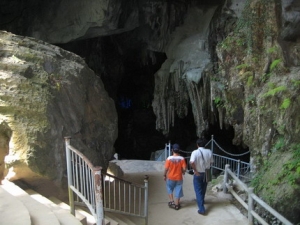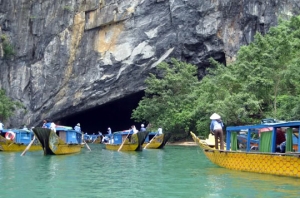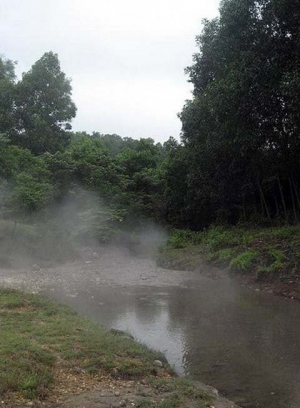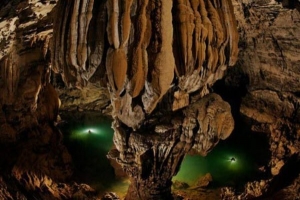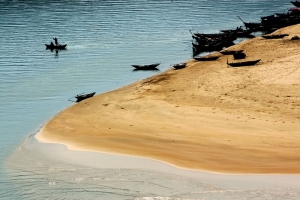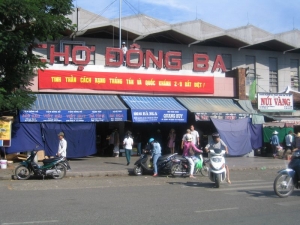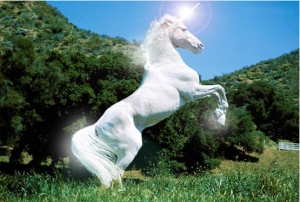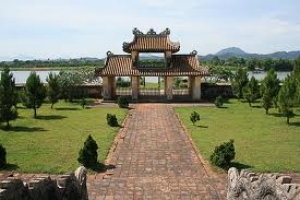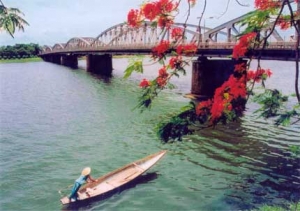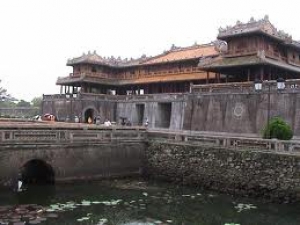
Asia Pacific Travel Team
Tien Son Grotto, a Natural Beauty-Spot in Quang Binh Vietnam
Tien Son Grotto, originally called Dry Cave, lies in Phong Nha - Ke Bang tourist complex that comprises natural beauty-spots in Quang Binh Province (central Vietnam). The site is now on the list to be recommended to UNESCO for recognition as a World Heritage Site.
Tien Son Grotto was discovered in April 1935 in the limestone mountain of Ke Bang. It is about 400 meters away from the famous Phong Nha Grotto and at a height of 135 meters.
Tien Son Grotto is more than 980 meters long. Going into the cave for about 400m, visitors in Vietnam travel will see an abyss, about 10m deep. Then coming to another part of the grotto, about 500m long, which is rather dangerous for walking. At present, nearly 400m of the cave have been installed with lighting system to make it safe for visitors.
The Grotto looks marvelous inside with hundreds of stalagmites and stalactites of different sizes and shape. Some look like a man or an animal, and there is one that looks like the Learning Tower of Pisa in Italy. On the cave ceiling, there are glittering gold and silver-like veins. Some stalagmites produce an echoing sound when slightly knocked.

Tien Son Grotto- Quang Binh Province
Limber Howard, Chief of the British Royal Team of Cave Researchers, who visited and made studies of the site, said that Tien Son cave may have been formed tens of millions of years ago. A river ran through the limestone mountain and eroded it. Then huge rocks fell, separated the mountain and form the cave. An under ground river ran through the lower part of the mountain, creating Phong Nha Grotto. Thus, Tien Son Grotto is older than Phong Nha grotto and they do not link with each other. Geographical tectonics in Tien Son Grotto are rather stable, so the cave is safe for visitors joining tours in Vietnam.
It’s recommended that Tien Son grotto is a good place for tourists who want to explore the marvelous and gigantic beauty of this grotto.
Phong Nha-Ke Bang National Park- A world Natural Heritage recognized by UNESCO
Phong Nha-Ke Bang National Park is located to the north of the majestic Truong Son Range in central Quang Binh Province. It protects one of the world's two largest karst regions with several hundred caves and grottoes. Its name derives from Phong Nha cave, the most beautiful one, with numerous fascinating rock formations, and Ke Bang forest. The plateau is probably one of the finest and most distinctive examples of a complex karst landform in Southeast Asia.
Location:
Geographically, the Phong Nha-Ke Bang National Park (PNKBNP) is located in central Vietnam, about 500km south of the capital, Hanoi, within the Quang Binh Province.
The western boundary of the Park partially forms Laos-Vietnamese border, which is only 42km from the sea. The Park is found within the geographical co-ordinates of 170 20'-170 48' N and 1050 46-1060 24' E in Bo Trach and Minh Hoa Districts.
Recognition by UNESCO in 2003
Phong Nha-Ke Bang National Park was first nominated as a UNESCO World Heritage Site in 1998. The dossier submited to UNESCO was for the recognition of Phong Nha nature reserve as a world natural heritage under the name “Phong Nha Nature Reserve”. The reason given for the nomination was that this nature reserve satisfied the criteria of biodiversity, unique beauty and geodiversity (criteria I and iv).
It was recognized as a world natural heritage site at the UNESCO's 27th general assembly session being held in Paris in June 30th – July 5th, 2003. At the session, delegates from over 160 member countries of UNESCO World Heritage Convention agreed to include Phong Nha-Ke Bang park and 30 others worldwide in the list of world heritage sites. Phong Nha-Ke Bang National Park meets with criteria viiii in accordance with UNESCO’s appraisal scale since it displays an impressive amount of evidence of earth’s history and is a site of importance for increasing human understanding of the geologic, geomorphic and geo-chronological history of the region.
Physical features:
Phong Nha is part of a larger dissected plateau, which also encompasses the Ke Bang and Hin Namno karsts. The limestone incontinuously demonstrates the complexity interbedding with shales and sandstones. This, together with the capping of schists and apparent granites has led to a particularly distinctive topography.
Looking into the caves, you may recognize discrete episodic sequences of events, leaving behind various levels of fossil passages, formerly buried and now uncovered palaeokarst (karst from previous, perhaps very ancient, periods of solution); evidence of major changes in the routes of underground rivers; changes in the solutional regime; deposition and later re-solution of giant speleothems and unusual features such as sub-aerial stromatolites. The location and form of the caves suggest that they might owe much of their size and morphology to some as yet undetermined implications of the schists and granites which overlay the limestone. On the surface, there is a striking series of landscapes, ranging from deeply dissected ranges and plateaux to an immense polje. There is evidence of at least one period of hydrothermal activity in the evolution of this ancient mature karst system. The plateau is probably one of the finest and most distinctive examples of a complex karst landform in SE Asia.
Cultural heritage:
The oldest evidence of human occupation of the area are Neolithic axe heads and similar artefacts found in some of the caves. There are some relics of Ham Nghi King, a final King of the Nguyen dynasty before the French colonial period, at the Maria Mountain in the north of the Park. Currently the Arem, Ma Coong and Ruc ethnic groups live in two villages in the core zone of Phong Nha Ke - Bang National Park. Until 1962 these indigenous people lived in the forest in houses made of bamboo and leaves or in the caves, living from forest products and hunting. They used simple tools and their clothes were made from the bark of a toxic forest tree (Antiaris toxicaria) and lianas.
Since 1992 the Government of Vietnam has set up two new settlements for these 475 people, who are the two smallest ethnic groups in Vietnam. These people are familiar with a number of economically valuable species, especially precious timber such as Mun and Hue (Diospyros spp., Dalbergia rimosa), and oil-extraction from species such as Tau (Hopea hainanensis) and many medicinal plants. The Phong Nha Cave has long been a site of religious and touristic importance, with an old Cham Temple discovered in the cave and it was a site of worship in the ninth and tenth centuries. During the war with the USA the Phong Nha - Ke Bang forest and caves were a garrison and weapons store for the Vietnamese army.
Conservation value:
Phong Nha-Ke Bang National Park is of high conservation value as one of the largest areas of intact forest habitat remaining in Vietnam. As part of a continuous forest block with the neighbouring Him Namno Biodiversity Conservation Area in Laos it forms one of the largest areas of forest on limestone karst in Indochina. The presence of tall lowland forest, which is regionally threatened as a habitat type, in the National Park increases the area's conservation value.
Tourist activities
The number of tourists has increased dramatically since the park was listed in UNESCO's World Heritage Sites. Tourism activities in the area are the responsibility of the Trading and Tourism Department of Quang Binh province, with 280 international standard rooms in the province and 8 vehicles with capacities of 4 to 15 seats for tourist transportation. The forest guards of Son Trach commune in Bo Trach district are placed on tourist security duty.
Quang Binh Province has invested into upgrading the Phong Nha-Ke Bang visitor site to turn it into one of major tourist destinations in Vietnam.

Phong Nha-Ke Bang National Park
Multiple eco-tourist projects have been licensed for development and the area is being heavily developed by the province to turn it into a major tourist site in Vietnam. Phong Nha Ke Bang is part of a tourism promotion program called: "Middle World Heritage Road" which includes the ancient capital of Hue, the Champa relics of My Son, the city of Hoi An, nha nhac and the Space of Gong Culture in the Central Highlands of Vietnam.
Coming to this National Park, tourists in Vietnam travel can join interesting tourist activities which are organized by Vietnam travel agencies located in the locality and there are various types that the tourists can choose:
Tour for expedition of caves and grottos in boats and with professional cave expedtion means.
Ecotourism, discovering the flora and fauna in this national park in the Ke Bang Forest.
Mountain climbing: There are extreme sloping mountains here with a height of over 1,000 m, which is a real challenge for adventurous climbers.
Phong Nha-Ke Bang National Park
In order to facilitate the increasing flow of tourists to the site, the Dong Hoi Airport was constructed and is due to be operational at the end of 2008.
Phong Nha-Ke Bang, together with Ha Long Bay and Fanxipan of Vietnam, is listed as a candidate for 7 new world natural wonders vote. As of February 12, 2008 it ranked 10th in the voting list.
Phong Nha displays an impressive amount of evidence of earth’s history. Paying a visit to Phong Nha- Ke Bang National Park, visitors joining tours in Vietnam not only increase their understanding of the geologic, geomorphic and geo-chronological history of the region but also take part in interesting tourism acitvities which make them relaxed and comfortable.
Bang Mineral Hot Spring- A place for huge tourism potential
Bang Mineral Hot Spring is located 60km to the south west of Dong Hoi City, in Kim Thuy Commune, Le Thuy District, Quang Binh Province. It has been recorded as the only hot water source in Viet Nam with a mineral water source. The mineral water source of Bang Spring is very good in treatment of several diseases. In addition, this hot spring is potential for resorts. Investments have been made on several ten hectares of the land area for the development of swimming pools, spas, accommodation, and tourist services to make Bang Hot Spring a favorite resort and wellness tourism destination of both international and domestic visitors.
Quang Binh authority and Cosevco Bang Mineral and Tourism Company are step by step investing in this potential area to create the best services which are helpful and useful for visitors in Vietnam travel. The investment process is just beginning with the aim of developing the area without causing any harm to the ecological environment and the natural landscape.
Besides health and eco-tourism, the Southern Quang Binh tours with many privileged natural landscapes are also favored tourist attractions of the area. These tours will provide tourists with memorable visits to the national General Vo Nguyen Giap exhibition house, the tomb and temple of mandarin Nguyen Huu Canh who greatly contributed to the national expansion to today Camau Cape, picturesque An Ma Lake and many other cultural and historical vestiges
In near future, Bang mineral hot spring will become a valuable site not only for health treatment but also for tourism.
Son Dong discovered to be the biggest cave of the world
Son Dong cave, discovered by a local 20 years ago, is more than 200 meters wide, 150 meters high, and at least 6.5 kilometers long, though the explorers said they were unable to explore it fully. British explorers have recently discovered that Son Dong is much larger than the world’s biggest known cave. The biggest section of Son Dong is five kilometers in length, 200 meters high and 150 meters wide, said Howard Limbirt of the British Cave Research Association team searching the area April 10-14, 2009. Son Dong is much larger than Deer Cave in Malaysia, currently considered the world’s largest, an explorer said (Deer is 90 meters wide, 100 meters high and 2 kilometers long). The Son Dong cave has replaced to take pole position as the world’s largest cave.
The Son Dong is situated below another cave in Phong Nha-Ke Bang, though its entry passage is very difficult to traverse. The exploration team said they had set foot on just 6.5 kilometers along the cave, as there is a large amount of fast flowing water inside Son Dong. It takes explorers six hours of walking through a 10 kilometer long forest path from Truong Son Highway to reach the mouth of Son Dong cave. The explorer added that the Quang Binh cave has beautiful stalactites and stalagmites that are not seen anywhere else.
Phong Nha-Ke Bang grotto system belongs to the Phong Nha-Ke Bang National Park. It is a limestone region of 2,000 square kilometers in Vietnam and borders another limestone area in Hin Nammo in Laos. When describing the newly-discovered cave, the team’s spokesman, Haward Limbirt, said that it was a thing of overwhelming beauty and grandeur. He added that each grotto has its own beauty, but he is impressed by Ca Xai. This cave is near the Vietnam-Laos border. It is very deep and has a big lake inside. Explorers measured the depth of this lake, but they had only 200m of rope and the end didn’t reach the lake bed.

Son Dong Cave - Quang Binh Province
If you come to visit Phong Nha-Ke Bang National Park in central Quang Binh Province, you should take some hours to discover Son Dong cave which still preserves its natural beauty.
Lang Co Beach- One of the World’s Most Beautiful Bays
Situated on the central coast of Vietnam, which is famous for many beautiful beaches. Lang Co beach, since June 2009 has become an official memnber of the “World’s most beautiful bays” club. Today, it is a popular destination for tourists in Vietnam travel, especially for those who love beach so much.
With the length of approximately 10km, Lang Co beach located in Lang Co town, Phu Loc district,Thua Thien- Hue province is next to the National Highway 1A and near Hai Van Pass. It is considered an ideal place for beach lovers. Situated on the central coast of Vietnam with many famous beautiful beaches, Lang Co with its gradually slopping, white sand, blue sea, and the average temperature of 25oC in the summer, is an attractive destination for both domestic and international tourists in Vietnam travel.
Most tourists joining tours in Vietnam are attracted to this beach because of its attractive natural landscape. Lying on the most beautiful curve of the country, Lang Co has almost everything that the nature can offer: green mountains and tropical forests, smooth white sand, full of sunshine and cool, blue and clear sea as crystal. It is the 3rd bay of Viet Nam, after Ha Long and Nha Trang named in the list of 30 most beautiful bays in the global.
So stunning, in the Nguyen Dynasty, the Royal Step-over Palace named Tinh Viem (abating the hot weather) had been built here for the king's family members. The French also left their traces here, related to the name of this land. Lang Co, it is probably derived from "Lang Co" (literally means Stork Village) or L 'An Cu (An Cu - Settle down) - its original names when the French pronounced as Lang Co. Nowadays, many modern resorts has been going to build here.
It can be said that nobody can resist a nature beauty like Lang Co town. This small and peaceful town will give you the most relaxing time and many games at the beach. In addition, you will have good time to enjoy the seafood with various kinds of shrimps, lobster, sea shrimp, crab, butter-fish, mackerel fish, oysters, etc and not far from the beach are some attractions such as Lang Co fishing Village, Chan May scenery.
Lying on the "Central Heritage Road", Lang Co is very close to other famous attractions such as the Imperial City of Hue, Hoi An Ancient Town, Son Tra Peninsula where the famous Son Tra Natural Reserve and beautiful beaches located, and so many more. The beauty of Lang Co Bay, Hai Van Pass, Bach Ma National Park and a fishing village in this area always attract many tourists in Vietnam tourism by a wonderful harmonious combination between human and nature.
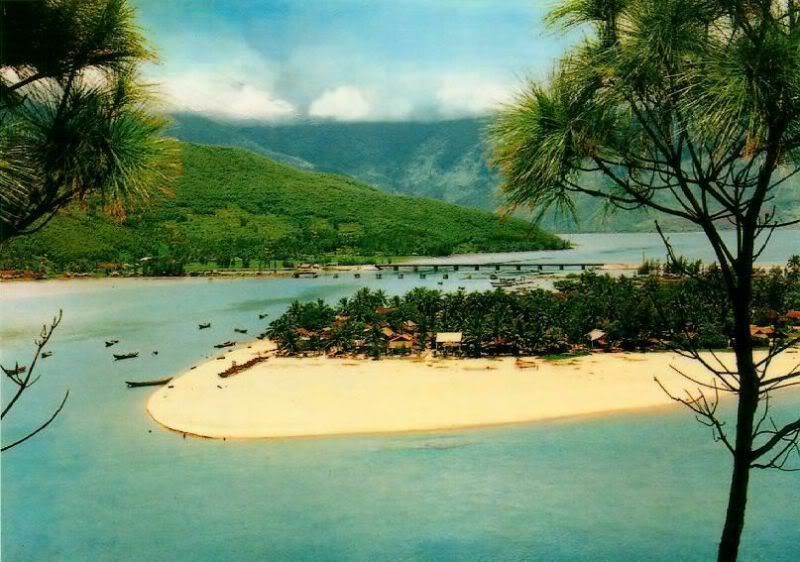
It’s about 60km from the centre of Hue City but about 40km from Phu Bai International Airport to Lang Co beach. If visitors drive to Lang Co from Da Nang City through Hai Van Tunnel, the longest road tunnel in Southeast Asia, the distance will be about 25km. However, the longer way, about 40km, is still the choice of many adventure lovers to drive on the pass to contemplate the beauty and majestic of Hai Van Pass and Lang Co Bay from above.
If you pay a visit to Hue, you should once visit Lang Co beach where you can have the most relaxing time and admire the natural beauty of landscapes.
Dong Ba Market – A symbol of Hue’s culture
Dong Ba market is the preservation of ancient distinctiveness. Tourists in Vietnam travel can see all the typical features of a traditional Vietnamese market, for example, the sampan landing, the bus station and the bazaars. Dong Ba market is considered as a paradise for snapshots of daily activities as well as for shopping with everything from souvenir items to bronze goods, Hue sesame sweetmeat, conical poem hats, just to name a few. You’d better come to explore this market if you want to find interest in Vietnamese culture or food.
Location
Image that you are roaming around this food market, you may find your visit to this city to be added with new colors. Around 100 kilometers north of Truong Tien Bridge, Dong Ba Market is situated near the eastern corner of the Citadel, in the north bank of the romantic Perfume River, near the place where the Dong Ba Canal merges with the Perfume River.
Story of naming and location
Visitors joining tours in Vietnam may be confused when they find several things here named “Dong Ba” in Hue city. Actually, Dong Ba is both the name of the largest market in Hue and of a small canal connecting the market with the busy river port of Bao Vinh, Lo Street and Thanh Ha. Dong Ba is also the name of the first steel bridge across the Dong Ba River and Dong Ba Street. The market was originally located outside the citadel's Chanh Dong Gate (also commonly called Dong Ba), where today stands a park at the end of Phan Dang Luu Street. The market was burnt down in the summer of 1885. In 1887, King Dong Khanh had it rebuilt and named it Dong Ba. In 1889, King Thanh Thai had it moved to the current location at the crossroads of the Huong (Perfume) River and the west bank of the Dong Ba Canal. Due to the convenient location, the market has always been very popular. In 1987, the market was under its greatest restoration, in which it was enlarged into a total area of 47,614 m2 with 9 ranges of sales houses, car parking place, motorcycles, bicycles shedding station, and so forth.
Dong Ba - the biggest market in Thua Thien-Hue
You are eager for purchasing craft products as Hue’s gifts for your dearests and fearest? Well, Dong Ba market is the right place to spend your precious time in this city. Not only being a largest-sized market in the past, Dong Ba market retains its role till now. It has always been providing "stage" for the traditional crafts in Hue, and sells to all those who are fond of; examples are Phu Cam conical hats, Hien Luong scissors, bronze articles of the Duc guild, Phuoc Tich pottery, Bao La rattan and bamboo products, Ke Mon jewelry, Nam Thuan sweets, Tuan tea, Huong Can mandarins, Luong Quan-Nguyet Bieu pomelos, and Tinh Tarn lotus.
Besides, for those who are interested in Southeast Asian food, the market supplies a lot during daytime, such as clam rice, beef noodles, shrimp cakes, pancakes, bean puddings, sour shrimps, and My Lai shredded lean meat, which are popular Hue’s daily dishes. If you stay here on the occasion of the Lunar New Year, you can share the custom of the locals by buying "five-color" cakes, which are small & square cakes made of bean and rice powder. The name “five-color” derives from the cakes’ 5 colors of wrapping papers. When biting the cake, you can feel that it seems to immediately melt in the mouth, which is of uniqueness of Hue’s specialty. Hence, it’s advised that you try these as much as possible during your time in Hue, or else you will miss them so much after coming back to your country!
Cultural values
Nowadays, travelers in Vietnam tourism visit Dong Ba Market not only because they can buy myriad goods and local specialties, but because in their hearts it is a symbol of Hue's culture. What was the most delicate material cultural traits of the city can be found here in the local traditional products, like Phu Cam conical hat, Hien Luong scissors, etc., and the mentioned delicious specialties, such as mussel rice, rice noodle with beef, leaf cake, shrimp springroll, khoai cake, dau van pudding, etc. that people could not help tasting!
Eventhough Hue city has a lot of new markets emerged, and one no longer has to go far for shopping, Dong Ba remains the biggest and most significant market in both Hue and Central Vietnam. Tourists coming here may not be able to get out soon since they are so much absorbed by the interesting Hue’s typical goods.
Today, Dong Ba Market plays an important role in the field of Hue’s economic development. If you are in Hue, Dong Ba Market should not be ignored. It will help you understand more about Vietnamese food or culture in general and Hue’s food or culture in particular.
Admire breathtaking natural landscapes in Bach Ma National Park
Lying 50 km south of Hue city, Bach Ma National park has a temperate climate much like that of Dalat, Sapa and Tam Dao. However, since it is located so close to the sea, the highest temperature in summer never exceeds 26oC and the temperature in winter never goes below 4oC.
Thanks to these advantages, the French transformed Bach Ma into a summer resort in the early 1930s. The area comprises 139 villas and auxiliary buildings, such as the post office, bank, tennis court, etc. Unfortunately, the war and lack of maintenance have significantly affected these constructions.
After 10 years of reunification, the State established a network of 87 natural reserves including Bach Ma in 1986. It was officially founded on 15 July 1991.
Coming to this National Park, visitors in Vietnam tourism are attracted to its breath-taking natural landscapes. The highest peak is Hai Vong Dai (Sea Observation Post), 1,450m high, where people can have a panoramic view of the immense sea and surrounding scenery. Do Quyen Waterfall is astounding and huge in the wooded mountain. It is more than 300m high and 20-30m wide. It is amazing to watch the silver water running into the bright red of water-rail flowers. Bac Chi Waterfall, about 20m high, roars all year round. Five lakes - a system of large lakes - has clean and cool water, created by the block of black granite stretching along Kim Qui Spring. This is a good place for camping, bathing, and outdoor activities.
Moreover, Bach Ma National Park is still home to 931 species of animals of which 83 wildlife species, including tigers and monkeys. It also houses 333-odd species of birds known to inhabit Vietnam. More than 1,406 species of plants have also been identified.
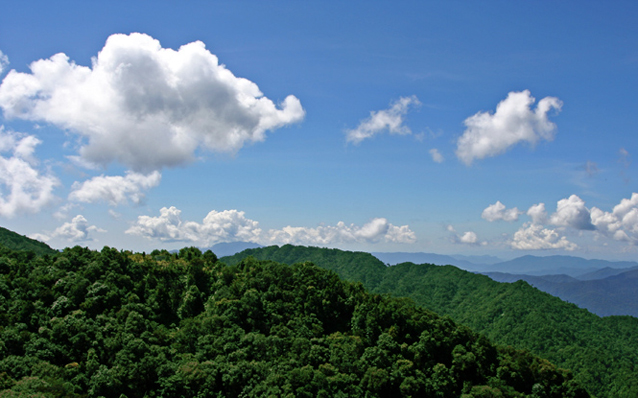
Besides an interesting eco-tourism destination to tourists in Vietnam travel, the Bach Ma National Park has an advantage of being close to Vietnam's three world cultural heritage sites (Hue Imperial City, Hoi An Ancient Town and My Son Cham Towers).
Therefore, tourists joining tours in Vietnam usually add the park to their itinerary. With highly-valued natural resources, Bach Ma does not only gratify thousands of visitors but also attract scientists. The best time to visit Bach Ma is from February to September. It is open from 7 am to 5pm.
Hue Temple of Literature- A unique symbol of Vietnam’s past educational system
During the old time, various Temples of Literature were built by the Nguyen Lords in the capital and moved to three different places: Trieu Son Village, Luong Quang Village and Long Ho Village. Hue Temple of Literature , also called Van Mieu Hue in Vietnamese language, is a worship temple founded by the Nguyen Dynasty to dedicate to celebrated scholars of Confucianism.
In 1808, Gia Long and his Imperial Court decided to choose a low hill beyond the Thien Mu Pagoda, on the left bank of the Perfume River, i.e. the current position, to built a new imposing and striking Temple of Literature. The construction of the Temple of Literature was commenced on April 17th, 1808 and finished on November 12th, 1808.
The Temple of Literature faces south. All main constructive works were built on the top of the hill, three meters higher than the surrounding land. In front of it was the Perfume River, in the back was villages, hills and mounts spreading from Truong Son Range. All items of Hue Temple of Literature were erected on a square surface of 160m long on each side enclosed by La Thanh (surrounding wall). There was once a complex of 50 big and small constructions including 32 steles which bore names of doctors and four other steles.
The Temple of Literature was many times renovated and many sub - constructions were built, especially in Minh Mang and Thieu Tri's time. From Minh Mang's time onwards, National Examinations were held so that steles bearing the names of successful candidates were erected here. These "Tien si de danh bia" - "Steles bearing doctors' names" were gradually erected on the yard of the main temple from 1831 to 1919, the year in which the last National Examinations was held in Khai Dinh's time.

"Steles bearing doctors' names" in Hue Temple of Literature
As destroyed by the war and weather, the remains of the Temple of Literature are now the 34 steles of great cultural and historic value. On these steles are names, ages and places of birth of 239 successful candidates in National Examinations organized in the Nguyen Dynasty.
Today, visiting Hue Temple of Literature, tourists joining tours in Vietnam can see the unique symbol of Vietnam’s past eductional system. They can understand more about the tradition of knowledge appreciation, scholars administration and study encouragement of our ancestors during the feudal times.
Perfume River ( Sông Hương River)
A visitor to Hue once remarked after his vacation here: “A visit to Hue would not be complete without a boat excursion on the gentle Perfume River, or else you cannot feel the romance of Hue
Source and flow
ThePerfume River has two sources, both of which begin in the Truong SonMountain range and meet at Bang Lang Fork. The Ta Trach (LeftTributary) originates in the Truong Dong mountains and flows northwesttowards Bang Lang Fork. The shorter Huu Trach (Right Tributary) flowsthrough the Tuan ferry, landing towards Bang Lang Fork.
Then it flows in south-north direction passing the temples of Hon Chen and Ngoc Tran, and turns north-west, meandering through the Nguyet Bieu and Luong Quan plains. From this, the Riverthen continuously flows int the north-east direction to Hue city, onlyan echo of Truong Son mountain, and passes the rest place of the NguyenEmperors. The river of green water continues its itinerary, passing HenIslet and various villages, crossing the Sinh junction, which is knownas the capital of ancient Chau Hoa, before emptying into the Tam GiangLagoon.
FromBang Lang to Thuan An estuary, the Perfume River is 30 km long and runsvery slowly (as the river level is not much above sea level). ThePerfume River darkens as it winds along the foot of Ngoc Tran Mountain- home of the Jade Cup Temple - where there is a very deep abyss.
Artist inspiration
The poetic romantic Perfume River is the deep inspirations to numerous artists, poets, and composers;
"Who turns to Hue
Who comes back to Ngu Mount
Who comes back to Huong River
The river water never sinks
Ngu Mount birds fly back to friends
Whoever are children of Hue remember to return…”
arethe beautiful lyrics of a famous song, “Who comes to Hue”, written byDuy Khanh. In the autumn, flowers from orchards upriver from Hue fallinto the water, giving the river a perfume-like aroma, and a beautifulpoetic view. I have asked several artists about the reason for theirinspiring love for Perfume River, and received nearly the same answer:“Well, my inspiration derives from the pure water, the fascinatinglandscape, and the gentle bridge over the river”.
Today,travellers coming to Hue could not miss a while of boating along theriver. Most of them admit that this is one of the most beautiful andextremely splendid riverside landscape (especially at night when lightsare on) that they have ever visited!
A river tour

Perfume River at night
Asmentioned, the river flows through a series of beauty-spots, takingvisitors to every corner of the ancient citadel when you travel byboat. Along the river, you can visit Da Vien, Phu Xuan, and Truong TienBridges, come to the Tomb of Minh Mang, Hon Chen Shrine, Thien MuPagoda, and finally to bathe in the sea. Upstream, at the Tomb of ThienTho, you can hear the rustling of the pine tree, which may help youbecome a… poet!
Whenthe night comes, the surface of the river glistens under the moonlight,and the songs of the boat rowers can be heard breaking the silence.Just come here and you will feel the pure atmosphere of romance andbeauty!
Hue – an ancient citadel of Vietnam
Hueis located in central Vietnam on the banks of Perfume River (SôngHương), just a few miles inland from the East Sea. It is about 700kilometers (438 miles) south of the national capital of Hanoi and about 1100 kilometers (690 miles) north of Hochiminh City.
History
Hue people take their pride in a long-lasting history. The city has gone through 7 centuries of establishment and development. In1802, Hue became Vietnam’s capital when Emperor Gia Long, the firstKing of the Nguyen emperors (Nguyen dynasty), chose the location forthe imperial city. The city remained the nation’s capital until 1945,when Bao Dai, the last of the Nguyen emperors, abdicated and acommunist government was established in Hanoi. In the Vietnam War,Huế's central position placed it very near the border between NorthVietnam and South Vietnam. Thanks to the long precious history, Hue has integrated material and spiritual values, which become its own unique special Culture.
Natural conditions
Thecity has 2 main seasons: dry season and rainy season. The former isfairly hot, lasting from March to August, while the latter begins fromAugust, and is cool and wet. But the most special point is the shortspring lasting from January till February, with a very cool and freshatmosphere and green purity of new tree leaves here and there. Thismeans if you would like to visit the city but still afraid of the hotor wet weather, please come in between January and February.

Culture
Imperial Citadel and & tomb Architecture
Hueis one of the main cultural, religious and educational centers ofVietnam. So far, Hue remains to be the only originally historicalvestiged city in Vietnam. Many of Hue’s attractions are found along thebanks of the romantically named Perfume River with 11km length. This valuable construction includes more than 100architectural works, which are the reflection of the life of Emperorsand mandarins under Nguyen’s reign.
Architecturein Hue is the combination of royal architect, folk, religious ones,tradtional and modern sides. On December 11th, 1993, it was classifiedby UNESCO as the world cultural heritage. On the north bank of theriver is the Imperial Citadel,built along the line of Peking’s Forbidden City, enclosed by 10-metrethick walls and surrounded by a moat. A few kilometers further up theriver are perhaps Hue’s best-known religious site. Inside the citadel,there are still wonders. For example, the seat of the Nguyen emperorsoccupying a large, walled area on the north side of the river. Insidethe citadel was a forbidden city where only the concubines, emperors,and those close enough to them were granted access, the punishment fortrespassing was death penalty.
Ifyou like something mysterious and valuably architectural, you shouldtake a visit to the tombs of ancient Kings. Situated in the middle ofthe hills on the Southern bank of Perfume River are very beautifultombs of Nguyen Kings. Among these tombs are the four famous ones withthe name and the arrangements of the tomb reflecting each Emperor’spoints of view, personality, and tastes. This is majestic Gia Longtomb, imposing Minh Mang tomb, poetic Tu Duc tomb and magnificent KhaiDinh tomb. No architects who would like to discover ancientarchitecture of Vietnam could ignore Hue’s old citadel vestiges.

Royal Music
Alot of foreign tourists are curious about Hue’s ritual royal music.Originated from 8 kinds of ritual music under Le dynasty, under Nguyendynasty, it has improved into 2 kinds of music: “Dai nhac” and “Nhanhac”, which are really magnificent, and skillful. Those are onlyplayed on formal occasions. This city is proud to be the cadral oftraditional music. The Royal Refined Music was proclaimed by UNESCO asa Masterpiece of the Oral and Intangible Heritage of Humanity onDecember 1993.
Religion
Hueis also an important center of Buddhism. In Hue and the surroundingsstill exists tens of pagodas constructed more than 300 years ago, and ahundred of temples and pagodas built in the early century. Thien Mu Pagoda, with its distinctive seven-storey octagonal tower.
Besides all these, Hue’s culture is also found in its famous “non la” or conical hats. You can buy these at the enormous Dong Ba Market as a remarkable and graceful piece of souvenir of Vietnam.A foreign friend of mine had a chance to meet a long-haired Hue’sVietnamese girl in the traditional violet long dress and a gracefulconical hat. And can you guess what happened? He fell in love with herat first sight, and they are now a very happy couple – husband andwife!! Vietnamese cultural grace could win any heart!
Festival and Cuisine
Festivalsare also attractions of Hue. There are two main kinds of festival here.Royal festival reflects the life and ritual activities of Nguyendynasty, almost paying more attention to the ritual than the ceremony.Folk festival consists of multi activities such as Hue Nam festival inHon Chen temple which follow Champa’s belief, handicraft’s fathermemory festivals, and some cultural activities as boat racing,westling,…
Thecuisine of Hue are rich, but one of the most striking differences isthe prominence of vegetarianism in the city. Several all-vegetarianrestaurants are scattered in various corners of the city to serve thelocals who have a strong tradition of eating vegetarian twice a month,as part of their Buddhist beliefs.
No one who has come to Hue could ignore its ancient beauty and romance. Taking a cruise along the Perfume River, having some special cuisine, and listening to Nha Nhac Royal Music, you can feel the actual picturesque view of this natural classical mysterious city!
Activities
- Complex of the Temple for the Worship of the Nguyen Emperors (Thé Mieu)
- Complex of the mausoleum of King Minh Mang
- Complex of the Temple for the Worship of the Nine Nguyen Lords (Thai Mieu)
- Complex of the tomb of the King Tu Duc
- Complex of the Celestial Lady (Thien Mu)
- Complex of the Palace of Audiences (Dien Can Chanh)
- Chronological table of the monuments of Hue


